Jason Davis • Mar 07, 2019
Hayabusa2 Scores a Bulls-eye on Touchdown, More Explodey Fun on the Horizon
Hayabusa2 scored a near-perfect bulls-eye during its touchdown on Ryugu in February, according to a 5 March press briefing by JAXA officials. The mission is gearing up for more action-packed operations that include using explosives and a copper projectile to create a crater, and a possible second sample collection after that.
Hayabusa2, Japan's mission to Ryugu and other asteroids
Japan's Hayabusa2 spacecraft returned a sample from asteroid Ryugu to Earth in December 2020.
Touchdown recap
I already wrote about the incredible CAM-H video that shows 5 minutes and 40 seconds worth of images Hayabusa2 captured around touchdown, but here it is again as a refresher:
Hayabusa2 touchdown video This video of Hayabusa2's 21 February 2019 touchdown on asteroid Ryugu was created using frames from the spacecraft's small monitor camera (CAM-H). The video starts 59 seconds before final descent and the playback speed is 5x real time, covering 5 minutes and 40 seconds total.Video: JAXA
And here's a new stabilized GIF of the touchdown, by Jacint Roger Perez:
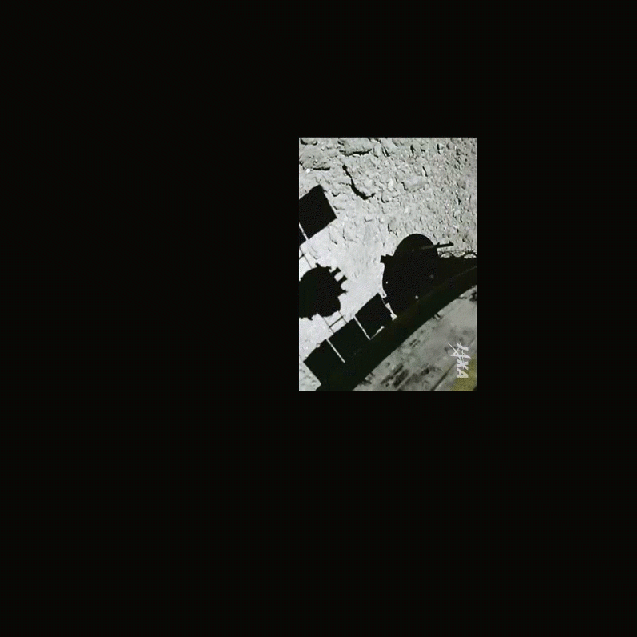
From all the debris it's pretty clear that Hayabusa2's tantalum bullet fired. JAXA also confirmed this by sensing a temperature increase in the gun barrel. (Since it's a FAQ: the bullet is made of tantalum so that if the bullet fragmented on impact, and fragments got into the sample chamber, scientists can easily distinguish bullet chunks from Ryugu chunks back on Earth.) Hayabusa2's sample horn hit the surface cleanly. Some of the debris you see flying around are fractured plates of rocks tens of centimeters wide.
I've been asked a couple times if any of that debris escaped Ryugu’s gravity entirely. The answer is: we don't know yet! The Hayabusa2 team is still looking at this. Ryugu’s escape velocity is a mere 38 centimeters per second—0.85 miles per hour, to put it in U.S. driving terms, or the walking speed of a penguin, to put it in penguin terms. The debris isn't moving quite as fast as it appears in the video; the frame rate varies between 0.2 and 2 frames per second, and the video compresses 340 seconds of action down to barely a minute.
Touchdown officially occurred at 22:29 UTC on 21 February 2019. You might recall that the touchdown site, L08-E1, was a circle just 6 meters wide:
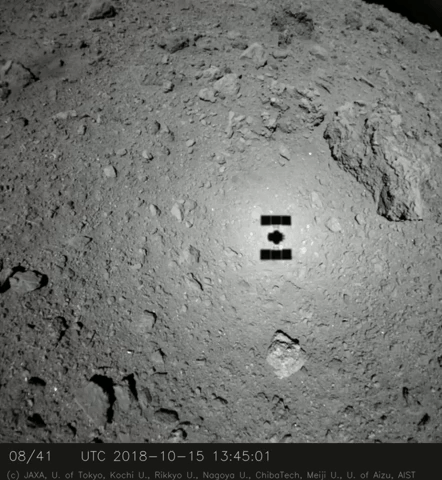
Hayabusa2 aimed for the center of that circle, and missed the center by just 1 meter to the northeast. It was a bulls-eye!
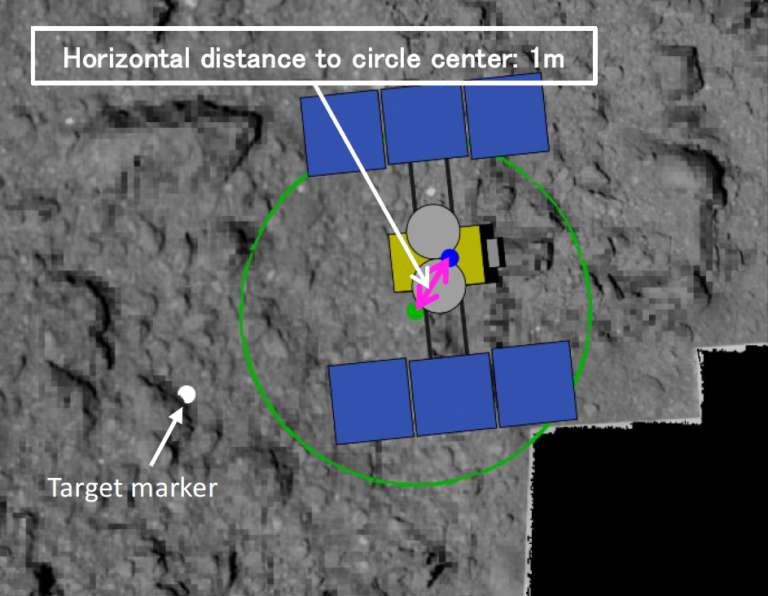
The team has unofficially named the landing site "Tamatebako," which means "treasure box," another nod to the Japanese fairy tale about a fisherman who gets a treasure box from an underwater dragon palace called Ryugu.
You might also recall that the start of Hayabusa2's descent to Ryugu was inexplicably delayed, and then, the spacecraft made up for lost time by speeding towards its Gate 2 checkpoint at 90 centimeters per second instead of 40. We now have an answer to what happened: Hayabusa2 was in a different position than expected when ground controllers prepared to start its descent. It sounds like this wasn't a major surprise; thanks to prior touchdown rehearsals and ground simulations the team was able to create and verify a new descent trajectory in just 5 hours, while Hayabusa2 sat patiently at its 20-kilometer starting gate. To keep the moment of touchdown at roughly the same time, they increased the descent speed, which also wasn't a big deal, because they've trained for speeds up to a full meter per second.
However, that’s not the reason touchdown occurred roughly 36 minutes earlier than predicted. Hayabusa2 reached its final 45-meter descent checkpoint right on time. From there, it was on its own, performing the final touchdown sequence via a series of automated checkpoints. A JAXA-provided timeline shows Hayabusa2 was much more efficient than predicted: In just 22 minutes instead of 58, the spacecraft locked on to the target marker, descended to 8.5 meters, moved horizontally to the final drop point, oriented itself, and free-fell to the surface. It’s quite a nimble little spacecraft!
With Hayabusa2's high-gain antenna turned away from Earth during the final descent, the only way ground controllers knew how things were going were Dopper shifts in the signal coming from the spacecraft’s low-gain antenna. Here's a neat graphic correlating Doppler data to Ryugu-relative speeds. It really shows how powerful of a tool Doppler data is for space missions.
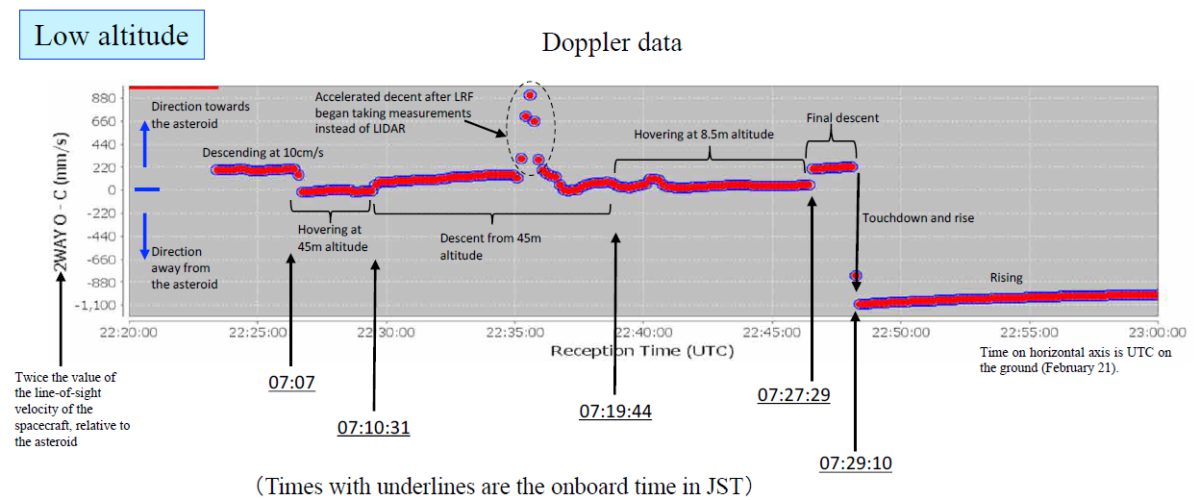
Based on that graphic, you can see why it was so obvious that touchdown occurred, prompting a cheer to go up from the control room!
[TD1-L08E1] 2/22 at 7:49 JST. The Doppler data showed the behaviour as expected and cheers went up with a clap!
— HAYABUSA2@JAXA (@haya2e_jaxa) February 21, 2019
What's next
The Hayabusa2 team is hardly resting on their laurels. They’ve only got until November or December before the spacecraft has to return to Earth.
Though Hayabusa2 can collect as many as 3 samples, it initially seemed doubtful that the team would attempt more than 1 because Ryugu's surface turned out to be much rockier than expected. However, the success of the first touchdown showed the team they can work with the challenging terrain, so they're already looking at a second potential sample site named S01. Like L08-E1, S01 is on the equator, about a quarter of the way around Ryugu to the east of L08-E1. As I write this, Hayabusa2 is descending for a closer look. It will get as close as 23 meters.
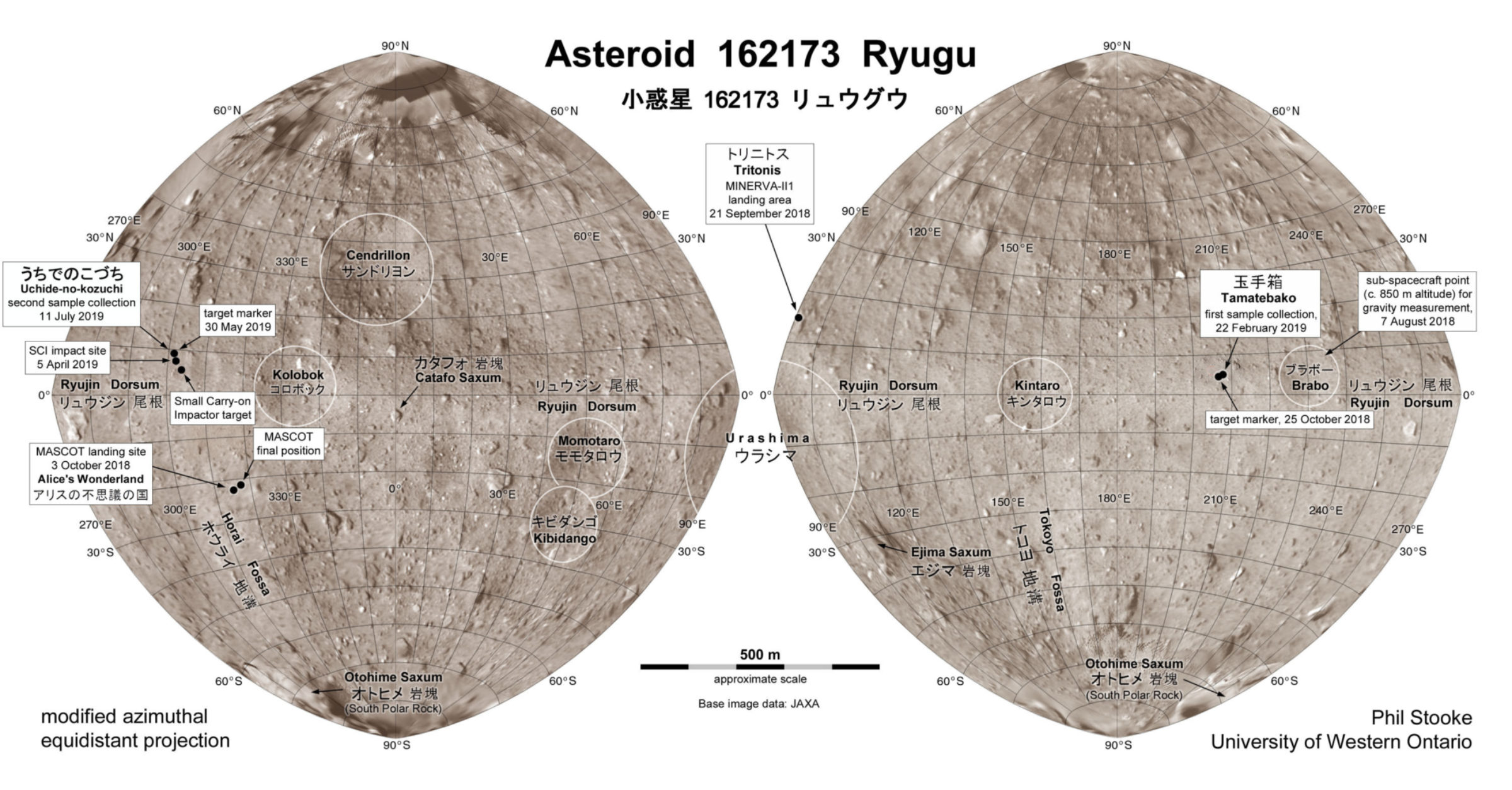
Before collecting a second sample, the mission will deploy an experiment called the Small Carry-on Impactor, or SCI. If you thought firing a tantalum bullet into Ryugu at 300 meters per second was cool, wait until you hear about SCI: Hayabusa2 will release a small box containing explosives and a lump of copper (once again, to differentiate the impactor from native Ryugu materials), along with a camera-equipped cylinder to observe.
Hayabusa2 will high-tail it behind Ryugu, and the explosives will detonate above the surface, shooting the copper lump into Ryugu at 2 kilometers per second, fast enough to create a crater a few meters in diameter. After the coast is clear, Hayabusa2 will return to the scene of the crime and observe the crater it made, getting a firsthand look at materials that were not previously exposed to space.
The SCI experiment is tentatively scheduled for early April. Then, the team will decide whether to perform a second touchdown, either in the artificial crater they just created, or at the S01 location they're observing now. A second touchdown wouldn't happen until June at the earliest.
There probably won't be a third touchdown, due to the challenging surface environment and the splattering of debris from the first touchdown onto one of the spacecraft's optical navigation cameras. The team also still plans to drop the third and final MINERVA rover no earlier than August, even though it has computer problems and might not return any data.
Let’s Go Beyond The Horizon
Every success in space exploration is the result of the community of space enthusiasts, like you, who believe it is important. You can help usher in the next great era of space exploration with your gift today.
Donate Today

 Explore Worlds
Explore Worlds Find Life
Find Life Defend Earth
Defend Earth



